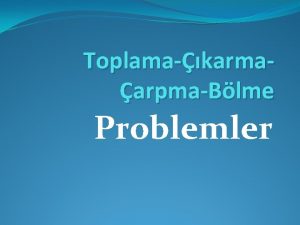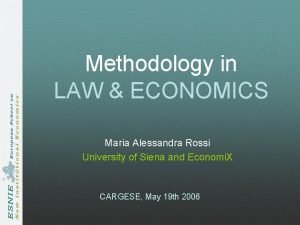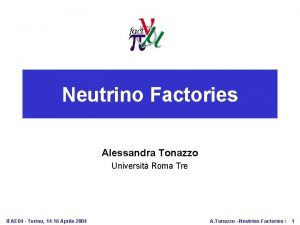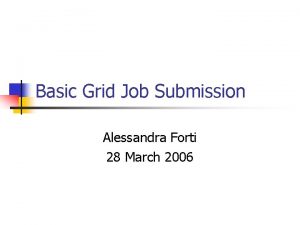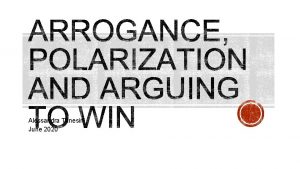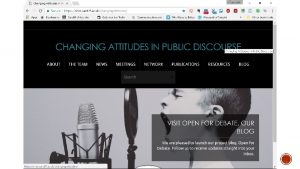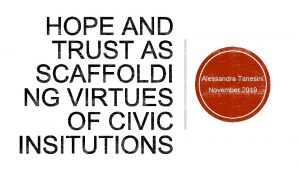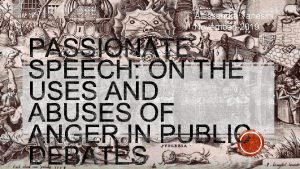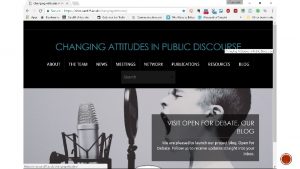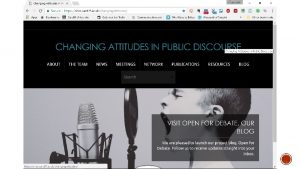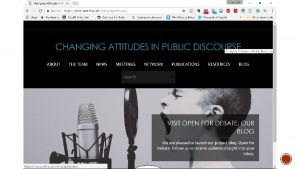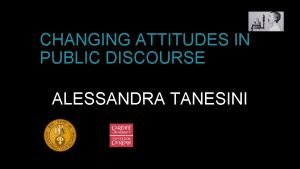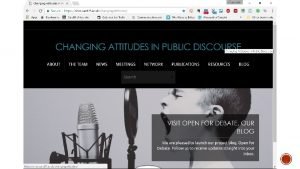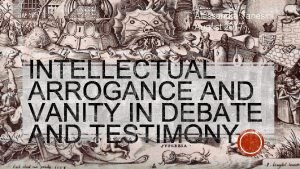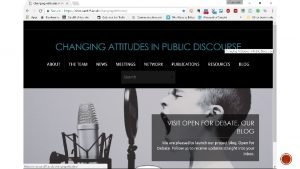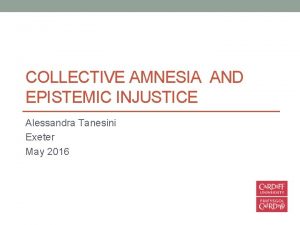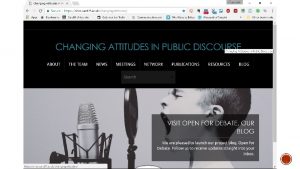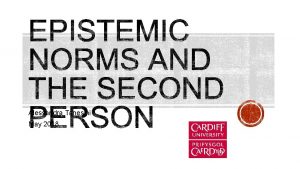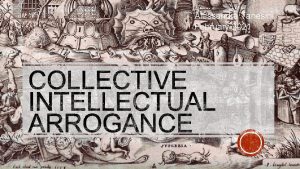Alessandra Tanesini June 2019 Explore some of the




![§ Anger is a “desire, accompanied by [mental and physical] distress, for apparent retaliation § Anger is a “desire, accompanied by [mental and physical] distress, for apparent retaliation](https://slidetodoc.com/presentation_image_h2/f31584eff70fe34027a7121b4b244c18/image-5.jpg)












- Slides: 17


Alessandra Tanesini June 2019

§ Explore some of the roles played by anger especially in debate. § Understand the relation between AIMS some forms of anger and some forms of ignorance § Develop a partial remedy to overcome the ignorance promoted by anger

§ What is anger § Arrogant Anger § The abuses of anger: humiliation and THE PLAN intimidation § Virtuous Anger § The uses of anger: understanding and holding responsible § The abuses of muting and silencing anger § Staying ignorant and fleeing discomfort § Staying with discomfort and hoping for understanding
![Anger is a desire accompanied by mental and physical distress for apparent retaliation § Anger is a “desire, accompanied by [mental and physical] distress, for apparent retaliation](https://slidetodoc.com/presentation_image_h2/f31584eff70fe34027a7121b4b244c18/image-5.jpg)
§ Anger is a “desire, accompanied by [mental and physical] distress, for apparent retaliation because of an apparent slight that was directed, without justification, against oneself or those near to one” (Aristotle, Rhetoric, 1378 a 30 -33). ANGER § Anger is a negative emotion in response to a perceived wrong § It includes a desire to redress the wrong § Anger can be virtuous when it is fitting and proportionate § Aristotle conceives of this as seeking to get even, but it need not be so.

§ Anger is a characteristic emotion of some vices of superiority. TWO FACES OF ANGER § It can be a reaction to a perceived threats to arrogated entitlements (privileges). § Anger is also a characteristic response of the subordinated to the wrongs of their subordination. § It can be a reactive attitude of moral indignation holding others responsible for their behaviour and demanding that they stop and/or make amends

§ Status anger as anger in response to a perceived slight § Status anger is often a reaction to the thwarting of a desire about social status or about positional goods ARROGANT ANGER § Status anger can be effective (payback can restore one’s possession of the positional good) § Anger is an implicit acknowledgment of vulnerability to threats § Status anger is often a manifestation of superbia because it is a means to gain superiority by doing others down

THE ABUSES OF ANGER: INTIMIDATI ON AND HUMILIATIO N § Status anger involves a disposition to get even by lowering others’ social status. § Status anger is manifested in debate by behaviours designed to § intimidate (shouting down, dominating floor) § humiliate (mocking, dismissing, etc).

§ Feminists of colour have long argued for the usefulness of anger (e. g. , Lorde, 1981; Lugones, 2003). VIRTUOUS ANGER § Anger as efficacious in the fight against oppression § It supplies energy and motivation but is a burdened virtue (Tessman, 2005) § It scares and pushes away individuals who are dangerous for one (Malatino, 2019)

THE USES OF ANGER: UNDERSTA NDING AND HOLDING OTHERS RESPONSI BLE § Anger is instrumental in the acquisition of moral knowledge. § Anger, like other moral emotions, directs attention to relevant evidence of a wrong. § Anger if unwarranted can mislead and make us misconstrue the moral status of some action. § Anger might be difficult to train (Lorde 1981; Pettigrove 2014). § Anger is also a reactive attitude. § Anger is a way to hold people responsible for their actions by communicating to them that what they are doing is wrong § It demands that they stop and/or make amends and thereby it supplies them with a reason to do so.

MUTED AND SUPPRESS ED ANGER § Anger is muted when it is silenced and thus treated as mere venting or overreaction rather than as a communicative reactive attitude. § Anger is suppressed when it is self- smothered so that it is not manifest but also inhibited overtime.

MUTING ANGER AS CLAIMANT INJUSTICE § When anger is muted it fails to communicate moral indignation and becomes mere venting. § One is thus deprived of the ability to address some moral claims to others § Claimant injustice occurs when one is, because of prejudice, systematically and wrongly deprived of the ability to hold others responsible (Carbonell, 2019).

§ Repeated self-suppression of anger might SUPPRESSI NG ANGER AS HERMENEU TIC INJUSTICE lead to the dampening down of anger because of § Rationalisation to reduce cognitive dissonance § Sheer depression § Dampening of anger damages one’s capacities to fully understand one’s situation § Rationalisation lowers self-confidence and atrophies some intellectual capacities § Denies one of a vital cue to develop understanding when conceptual resources are not already in place § This is an hermeneutic injustice since it harms one’s capacities to develop appropriate conceptual resources

§ Feminists of colour and more recently FLEEING DISCOMFO RT trans-women complain that their anger is often met by white feminists or cis-women with fragility. § “I speak out of direct and particular anger at an academic conference, and a white woman says, “Tell me how you feel but don’t say it too harshly or I cannot hear you. ” But is it my manner that keeps her from hearing, or the threat of a message that her life may change? ” (Lorde, 1981) § White Fragility is manifested in tears, fears, expressions of discomfort and guilt and a disposition to flee (Di. Angelo, 2011).

FLEEING DISCUMFO RT, STAYING IGNORANT § White fragility is a way of keeping oneself ignorant of one’s complacency and complicity in other people’s subordination. § This is active ignorance because it is ignorance motivated by the desire not to know.

WHITE AND CISFRAGILITY AS STRATEGY § White fragility seeks to be comforted thus promoting the suppression of anger § White fragility promotes fleeing discomfort thus fostering the muting of anger

HOPE AND STAYING WITH DISCOMFO RT § Staying with discomfort is essential to hear the angry message and to avoid being complacent about and complicit with widespread injustice. § How to resist white fragility and the concomitant fleeing of discomfort § Promote resilience and persistence (Di Angelo, 2011) § Foster hope (Applebaum, 2017)
 Sınıfımızda 14 sıra vardır
Sınıfımızda 14 sıra vardır June 2019 geometry regents answers
June 2019 geometry regents answers 2019 june calendar
2019 june calendar Some say the world will end in fire some say in ice
Some say the world will end in fire some say in ice Cake is countable
Cake is countable Some may trust in horses
Some may trust in horses What are some contact forces and some noncontact forces?
What are some contact forces and some noncontact forces? They say sometimes you win some
They say sometimes you win some Some say the world will end in fire some say in ice
Some say the world will end in fire some say in ice Sometimes you win some
Sometimes you win some Maria alessandra rossi
Maria alessandra rossi Alessandra laranja
Alessandra laranja Alessandra tonazzo
Alessandra tonazzo Alessandra minardi
Alessandra minardi Era paleozoica
Era paleozoica Alessandra forti
Alessandra forti Alessandra fermani
Alessandra fermani Alessandra aloisi
Alessandra aloisi
